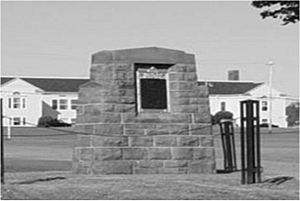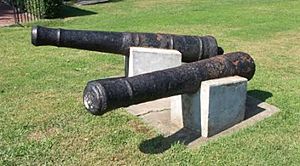Naval battle off Tatamagouche facts for kids
Quick facts for kids Naval Battle off Tatamagouche |
|||||||
|---|---|---|---|---|---|---|---|
| Part of King George's War | |||||||
 Naval Battle off Tatamagouche - National Historic Sites of Canada Plaque |
|||||||
|
|||||||
| Belligerents | |||||||
| Commanders and leaders | |||||||
| Paul Marin de la Malgue |
|
||||||
| Strength | |||||||
|
over 175 men four ships |
||||||
| Casualties and losses | |||||||
| "considerable slaughter" of French and Indians; "many slain" | none | ||||||

The Naval Battle off Tatamagouche happened on June 15, 1745. It was also called the Battle of Famme Goose Bay. This battle was a sea fight during King George's War. Three ships from New England fought against a group of French and Native American vessels.
The French and Native American group was on its way to help the city of Louisbourg. This group had four French ships and 50 Native American canoes. About 1,200 fighters were with them. Paul Marin de la Malgue led the French and Native American forces. Captain David Donahew led the New England ships.
The New Englanders won the battle. The governor of Ile Royal, Louis Du Pont Duchambon, thought that if Marin's help had arrived, the New Englanders would have stopped their attack on Louisbourg. Louisbourg had 1,800 French soldiers, while the New Englanders had 4,200. But because Marin's help was stopped, Louisbourg surrendered to New England the very next day.
Contents
What Led to the Battle
This battle took place during King George's War, which was part of a bigger conflict called the War of the Austrian Succession.
Early Events in the War
When the war started in May 1744, Captain David Donahew captured the chief of the Mi'kmaq people from Ile Royale, Jacques Pandanuques. The chief and his family were taken to Boston.
In May 1745, Paul Marin de la Malgue led 200 French troops. Hundreds of Mi'kmaq warriors joined them to attack Annapolis Royal. This attack, called the Siege of Annapolis Royal, lasted three weeks. Marin was then called back to help defend Louisbourg, so the siege ended.
Captivity and Reports
During the attack on Annapolis, the Wabanaki Confederacy (Mi'kmaq and Maliseet people) captured William Pote. He was with Gorham's Rangers. While he was held captive, Pote wrote an important story about his experiences. This story is one of the most well-known "captivity narratives" from Acadia and Nova Scotia.
While Pote was at Cobequid, he heard an Acadian say that the French soldiers should have "left their [the English] carcasses behind and brought their skins." Pote also wrote about the naval battle that happened off Tatamagouche.
The Battle Begins
Captain Donahew was on his ship, the Resolution, which had 12 guns and 50 crew members. He was sailing with Captain Daniel Fones on the Tartar, which had 14 guns and 100 crew. Captain Robert Becket was on the Bonetta, which had six guns.
The Chase and the Trap
The Tartar and Bonetta left the Resolution to chase smoke they thought came from a French and Native American camp. Soon after they left, four French ships appeared, led by Marin.
Captain Donahew saw the Native American canoes. He quickly raised a French flag on his ship. He wanted the Native Americans to think his ship was a French privateer that had captured an enemy ship.
The wind then died down, and the Resolution became stuck. It was surrounded by the French ships and canoes.
The Fight
At 10:00 AM on June 15, 1745, Captain Donahew lowered the French flag and raised the British flag on his ship. A fierce battle began, lasting two hours.
Donahew reported that he fired 200 rounds from his four-pound cannons at the four enemy ships. He also fired 53 rounds from his three-pound cannons. His smaller swivel guns and muskets were "continually playing on them." The British reported that many French and Native American fighters were killed.
Help Arrives
The four French ships were about to board Donahew's ship. But then, help arrived! Captain Fones and Captain Becket returned with their ships. Because of this, the French ships retreated to a place called Gouzar. The other two French ships went up a nearby river called Dewar's River. The Native American fighters stayed hidden behind a seawall.
The French and Native American convoy eventually retreated to Tatamagouche. They built defenses on land, expecting another attack from the New Englanders. Another New England ship then appeared. About a week after the first attack, the Huron people decided to leave the convoy and return to Quebec. They likely left because they had lost many fighters.
What Happened Next
This battle was very important for the fall of Louisbourg. Marin's group, which was bringing help, was stopped. Without this help, Louisbourg surrendered the very next day.
Weeks after Louisbourg fell, Donahew and Fones met Marin again. This time, Marin was near the Strait of Canso. Donahew and 11 of his men went ashore. They were quickly surrounded by 300 Native American warriors. Captain Donahew and five of his men were killed. The other six were taken prisoner.
On July 19, Donahew's ship, the Resolution, sailed slowly into the harbor. Its flags were flying at half-mast, showing sadness. The sad news about Captain David Donahew and his crew quickly spread through the fortress.
Remembering the Battle
To remember this battle, the Historic Sites Monument Board put up a monument in August 1939. It stands in Tatamagouche, looking over the harbor waters.
Captain Fones brought his ship, the Tartar, safely back to its home port in Rhode Island. Two cannons from the Tartar are now on the lawn of the Newport Historical Society. They used to be near the Oliver Perry Monument in Washington Square, Newport, Rhode Island.
See also



